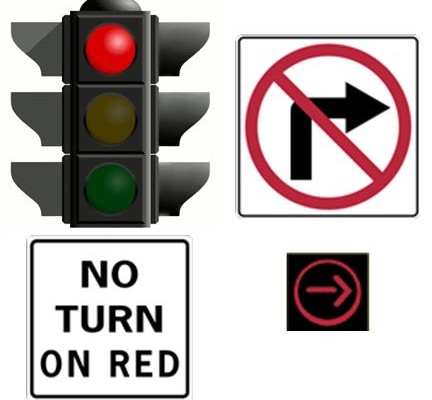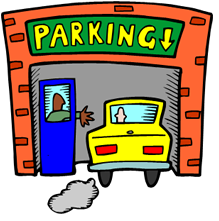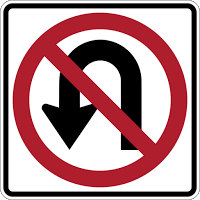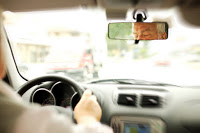Tag Archive: driver safety

Ask The Driving School Instructor: Right Turn On Red
September 23, 2014
Question: What are the rules for making a right turn on red?
Answer: There are several rules and things that you must watch for when making a right turn on red.
The first and most important rule – and this is the law in all 50 states – you must come to a complete stop at the red light before making a right turn on red. Failing to obey this law gets a lot of drivers in trouble either through involvement in a crash, or by receiving a ticket for running a red light. Many drivers, at intersections where red light cameras are installed, receive a ticket for running a red light because they seem to have forgotten this law and make a “rolling right on red.” Red means stop!
Making a right turn on red isn’t allowed at every intersection. If a “No Right Turn On Red” sign is posted, it’s illegal to turn. Sometimes, when the oncoming lane has a left turn light, an electric “No Right On Red” sign will light up. It’s your duty as a driver to be aware of all signs.
Other intersections may have a red right turn arrow. Just like a red light, a red right turn arrow means you must stop. However, in some states, Florida included, it’s legal to turn right on a red arrow after you’ve come to a complete stop unless there’s another sign posted that says “No Right On Red.” If you’re unsure of what the law is in your state, check your driving manual or, to be safe, remain stopped until you get a green arrow.
There are a lot of good reasons why you must come to a complete stop before making a right turn. Intersections can be a dangerous place and most crashes in the US happen at intersections. When you stop at a red light, before turning right, check for;
- Pedestrians that may be in the crosswalk – they have the right-of-way.
- Vehicles coming from the left on a green light (including bicycles and motorcycles) – they have the right-of-way.
- Vehicles in the oncoming lane turning left on a green left turn arrow – they have the right-of-way.
- Vehicles from the right that are making a U-turn at the intersection – they have the right-of-way.
- Pedestrians and bicyclists entering the intersection from the right- they have the right-of-way.
Another issue with right turns on red involves driver courtesy and good common sense. Sometimes, in heavy traffic, when traffic is backed up to the intersection, drivers must stop at the white line before entering the intersection to avoid blocking the intersection, if the light should change. Along with obeying the law, they are actually doing you a favor by keeping the intersection clear for you if your light should turn green. When you see a driver stop on a green light before entering the intersection, don’t take advantage of them by seeing that as an opportunity to make a right turn on red. It’s illegal, rude, and could lead to a road rage situation.
You’re only allowed to turn right on red if the way is completely clear of all pedestrians and other traffic. Don’t allow yourself to get in the habit of a rolling right turn on red.

Phobias and Driving – The Fear of Driving
June 25, 2012
Fear can be a good thing. Fear is a natural survival response and it can be a healthy response when it leads us to avoid certain hazardous conditions such as; avoiding dangerous places, being on the lookout for dangerous animals when hiking in the forest, or not swimming in a rapid river where you can easily be swept away. Driving is one of those situations where a good, rational, healthy fear of a dangerous environment can lead a driver to exercise reasonable caution, obey the traffic laws, and be on the lookout for situations or aggressive drivers that could pose a danger.
However, there are times when rational fear gives way to irrational fears. An irrational fear or phobia, can lead to avoidance of any situation that could possibly put the phobic individual in a position where he or she may encounter their fear. Most of us experience one type of phobia or another to a lesser or greater degree. Fear of snakes, spiders, or heights all have their basis in a good, rational concern for safety but when that fear turns into a phobia it can cause the phobic individual to experience a panic attack and freeze up.
Phobias involving driving take several forms with some overlapping and some combining other, overriding phobias:
- Fear of Driving – Some individuals have an overwhelming fear of driving itself. This could be as a result of post traumatic stress after being involved in a collision or just a fear of being involved in a collision. For some, the fear results from a fear of open spaces or crowds (agoraphobia).
- Fear of Driving Over Bridges – Some individuals have a fear of bridges themselves (gephyrophobia) and, for others, it isn’t the bridge but the height of the bridge (acrophobia) that causes the fear. Some major bridges such as the Tappan Zee Bridge in New York and the Chesapeake Bay Bridge-Tunnel provide replacement drivers to drive over the bridge.
- Fear of Driving In Mountains – This fear results from a fear of landslides, fear of heights, and fear of losing control of the vehicle on steep grades.
Emotions play a big impact on our driving and, when a driver experiences a fear so great that it can lead to a panic attack the phobia can be extremely dangerous both to the phobic driver and to the other drivers on the road. At this point, the driver needs to consider help in overcoming the phobia by consulting a therapist. Some therapists specialize in overcoming phobias.
Some feel that self help programs work as effectively as counseling. There are books available and some phobics have experienced relief through deep breathing and other relaxation techniques. Analyzing the irrationality of the fear and replacing the imagined catastrophic events with the more typical, realistic results can also help.

Parking Lot Safety
February 7, 2012
Finding a convenient and safe parking spot is as much a part of operating a vehicle as driving itself. Depending on the kind of parking situation, it can be as safe as being the only vehicle in that spot, or it might even prove to be more dangerous than the road itself.
Not all parking lots are created equal, even the parking spots don’t come in one flavor, hence the need for some parking lot safety tips.
Some parking spots may be a spot on the side of the road, or somewhere above a multi-tiered structure. Some spots may be straight-in, diagonal and some may not even have guiding arrows to help you. Paying attention plays a huge part in making sure you pick a perfect place to park.
Here are some of the necessary precautions when finding the perfect parking spot:
- Are the doors locked? Are the windows rolled up? Even if you’re leaving for a couple of minutes, you should always do this.
- As much as possible, don’t leave valuables in the car. Make it a habit: if you have the detachable type of GPS or radio, always bring it with you. GPS devices may make life easier, but if stolen, it gives thieves a treasure map to your house.
- Check your phone/plug in your earphones/do errands when you’re inside where you need to be. Your full attention is required in getting out of your car to getting to the destination.
- Is there parking security? If there’s an available spot within the view of security, park there. Not all parking lots are secure.
- Be wary of strangers loitering about the parking lot. The car may be parked, but they may be after you. Notify security if there’s anything out of the ordinary.
When your errands are complete, there are other precautions to be taken:
- Have your keys ready. Fumbling about and digging inside your purse or pocket for the keys in front of your car leaves you vulnerable.
- Always remember where you parked your vehicle.
- Scan the area around your vehicle. Be aware if someone may be following you.
- Check in and around your vehicle. Someone may be hiding behind your car, in front or in the back seat.
- Once safely in your vehicle, lock up and leave.
When backing out of a space, be aware of people or vehicles moving in front or behind your vehicle. Be aware that visibility may be limited when there are bigger vehicles parked next to you. Never put yourself at risk. A parking lot is just a place where you park, not to hang out in.
Additional Tips for Vehicle Theft Prevention from Department of Transportation’s (DOT) National Highway Traffic Safety Administration (NHTSA).

Making a Safe U-Turn
January 30, 2012
Intersection crashes cause the most number of fatalities more than any other crash location. Not only are they spots where red light runners might cause dangers, but also consider the fact that drivers making an innocent U-turn usually become involved if there ever was a crash.
What is truly important is: before making a U-Turn, make sure that you are aware of your state’s laws. Some states allow U-Turns at any intersection, unless there is a traffic sign that states: “No U-Turn Allowed”. There are other states that only allow for U-Turns when there is a “U-Turn Permitted” traffic sign. Almost all states do not allow U-Turns over double yellow lines painted on the road.
You may only make a U-Turn when the traffic light facing you is either a green arrow permitting a U-Turn, or a solid green light. Many people incorrectly assume that they can make a U-Turn while the light is red, even if their vehicle was a considerable distance from the center of the intersection. This is a violation, because doing so is still running a red light.
Here are some rules to making a safe U-Turn:
- Plan your U-Turn by looking for pedestrians or individuals riding bicycles. This means checking if you might hit someone or something when turning into the opposite direction.
- Always look in both directions before beginning your turn. If the light facing you has turned green, wait a second or two for possible red light runners coming from the opposite direction. This is the one tip that might save you the hassle of a crash.
- It’s a good idea to take your foot off the accelerator and moving it closer to the brake, should you need to stop, or when an emergency situation arises.
- If you have started your turn and the light changes, complete your turn as soon as traffic clears. Never try to back up in an effort to avoid blocking the intersection.
- It is important to note that you should always be making your U-Turn while you are at the left portion of the lane closest to the center line of the road. You are not allowed to make a U-Turn near the crest of a hill, a curve, or any other place where other drivers cannot see you from at least 500 feet away from the same direction.
U-Turns are the best way to get back to a location you missed, and making sure you know the right safety precautions while taking them assures you that you get there faster, and safer.

Remember the Time Change Can Affect Your Driving
November 2, 2011
It’s that time of the year again; time to fall back and set the clocks to Standard Time. The time change can cause disruptions while our mind and body adapt to the new time and that disruption can extend to our driving.
Changing back from Daylight Savings Time to Standard Time occurs on the first Sunday in November and that falls on November 6th this year. The time change officially happens at 2:00 AM on Sunday November 6th. Falling back means setting the clock back one hour; at 2:00 AM set your clocks back to 1:00 AM. The great thing about falling back is that we all get an extra hour of sleep on Saturday night. Those who don’t get the word will probably arrive at church an hour early and wonder where everyone is or why that football game hasn’t started yet.
The time change is always somewhat confusing because it takes our minds a few days to adapt to the new change. Those of you who are used to waking up and beginning your morning commute in the dark will be waking up to the sunrise. Those who enjoy the extra sunlight after work will be getting home in the dark.
The time change in the fall isn’t as disruptive as the spring time change. In spring we lose an hour of sleep and sleep experts say that losing even one hour of sleep can have an impact on our driving and driving while drowsy is just as dangerous as driving under the influence. However, even though we aren’t going to lose any sleep, our driving can still be affected because of the time it takes our internal clock to adjust to the change.
Our internal biological clock or circadian rhythm regulates our wake sleep cycle. It was easy before clocks were invented; we woke up at dawn and we went to sleep when it got dark. Sleep experts also say it is natural for us to become sleepy in the late afternoon. In the modern world, our days are regulated by the clock and that mechanical clock can sometimes come into conflict with our biological clock. Some sleep experts suggest that we follow the example of Mediterranean cultures and allow employees to nap in the afternoon in order to gain maximum performance. When we force ourselves to remain awake through that natural afternoon drowsy time, it can lead to drowsiness behind the wheel on the long commute home. One survey of drivers found that more than one-third (35%) of drivers who nodded off while driving within the previous six months say their last experience occurred between 6:00 a.m. and 5:00 p.m. An additional 17% report they nodded off between 5:00 p.m. and 9:00 p.m.
A study using mice (that also has implications for humans) found that when circadian rhythm cycles were disrupted, the mice didn’t perform as well in maze tests as the control group whose circadian patterns weren’t disrupted. They also exhibited impulsive behavior which, for human drivers, can mean trying to beat that light or pulling out in front of another car. When darkness suddenly falls an hour earlier, drivers may find themselves driving a little faster; trying to get home before daylight fades.
Another problem occurs because light conditions at dusk – before total darkness – can be confusing. Shapes that show up clearly in daylight or in a car’s headlights may not show up as clearly at dusk. A study conducted in 1995 found that the number of auto/pedestrian crashes increased substantially in the period following the time change back to standard time. Kids are still walking home from practice or trying to get in a little extra playing time with their neighborhood pals before total darkness. A University of California trauma center found a “62 percent increase in the number of children in auto-vs-pedestrian crashes and auto-vs.-bicycle crashes in the two weeks following the October time change. Of these victims, 90 percent had severe injuries and required surgery.”
Until their body clock adjusts to the new time, drivers should be especially cautious during the first few weeks after the time change. Get plenty of sleep, don’t give in to the impulse to rush home to beat the sunset, and be especially watchful for pedestrians.
Drowsy driving prevention week is Nov.6 – 12. For more information on sleep and sleep disorders, visit the National Sleep Foundation’s web site at: http://www.sleepfoundation.org/
